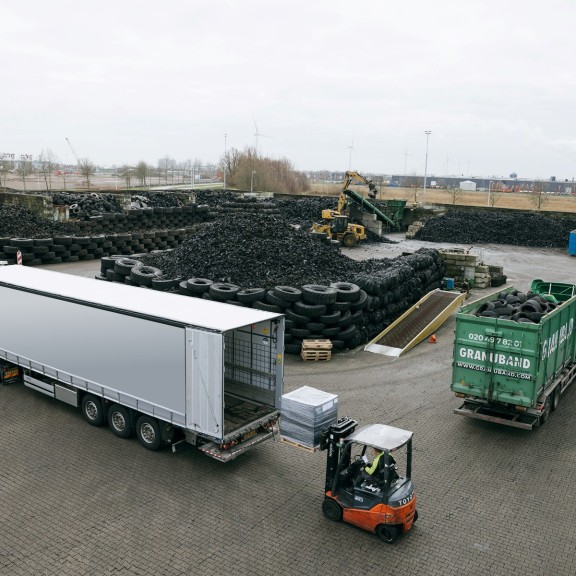
“We need to pick up the pace if we want to be fully circular by 2050”
At Siciliëweg in the Amsterdam port, Granuband processes all kinds of used car tires. As one of the early pioneers in the circular industry, we wanted to find out how they're doing now. Maarten van Randeraat, founder and director at Granuband, and his colleague Marco Alderlieste, General Manager, gave us an update: “We’re ready to accelerate, but legislation and regulations are holding us back.”
Since the 1990s, Granuband has been involved in the collection and processing of used car tires. At their site in Amsterdam, the tires are collected and transformed into new, sustainable, and circular materials. Marco explains: “We have machines that allow us to make all kinds of things from tire rubber tiles, ladder mats, and many other applications. The craziest things you can imagine, we can make them.”
Soon, Granuband’s activities will expand to other locations across the country, as the company became part of the Circtec Group earlier this year, Maarten adds: “Circtec is a leader in the processing of used rubber tires through pyrolysis technology—a form of chemical recycling. Circtec is currently building the largest pyrolysis plant in Europe, in Delfzijl. This technology transforms worn-out tires into renewable marine fuel, circular naphtha, and recycled carbon black. We will be responsible for supplying the discarded rubber that the plant processes.”
Rapid developments and new technologies
Innovation is moving quickly at Granuband, Marco continues: “We’re receiving more and more types of tires. To process them efficiently and with high value, we need new technologies.” Making a tire fully circular comes with several challenges, he explains: “One of them is maintaining the desired properties of the rubber material while keeping costs down. The wide variety of tire compositions makes the process complex and demanding.” Overcoming these hurdles requires close cooperation between tire manufacturers, governments, and other stakeholders.
So, what can Granuband do to make tires truly circular? Marco: “To return the right materials to tire manufacturers, a uniform composition is essential. That means we need to precisely categorize used tires based on their properties and makeup. That’s where we’re investing.” A good example is the new facility built this year at the Amsterdam port site: “It houses several robotic presses that can produce bonded rubber products. We’re also working on designs for a new sorting system, which will identify tires with enough tread for a second life. That process, too, will be fully automated,” Maarten adds.
Legislation slows innovation
Unfortunately, new innovations at Granuband are sometimes hindered by regulations, Maarten says: “The government has set the goal to be fully circular by 2050, but that won’t be achievable with the current permitting system and legislation. The rules are still open to multiple interpretations and make it difficult to take big steps. That slows things down.”
So, what should the government do differently? Maarten: “Be proactive. I understand that laws and regulations evolve, but it’s important that progress doesn’t get strangled in red tape. If we want to be fully circular by 2050, we need to pick up the pace now.”
Giving it a push
Granuband emits no emissions in the process of transforming used tires into new products. Still, there’s room for improvement, Marco believes: “We’re not yet fully powered by green energy, though we’d like to be. But it also has to be economically feasible.”
Looking ahead, Maarten and Marco hope that legislation will better align with the speed at which circular businesses are developing—not just nationally, but also internationally. Still, both men remain optimistic: “What we can do is give it a push. And we’re already doing a great job creating fantastic products from the tires we collect. We have a mission—and we’re going to make it happen.”